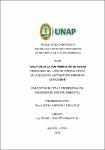| dc.contributor.advisor | Chávez Vásquez, Rafael | |
| dc.contributor.author | Peña Diaz, Diana Marshely | |
| dc.date.accessioned | 2019-02-18T03:59:09Z | |
| dc.date.available | 2019-02-18T03:59:09Z | |
| dc.date.issued | 2018 | |
| dc.identifier.uri | http://repositorio.unapiquitos.edu.pe/handle/20.500.12737/5802 | |
| dc.description.abstract | La investigación se desarrolló en los alrededores del lago Morona Cocha;
provincia de Maynas, departamento de Loreto, con el objetivo de determinar los
niveles de contaminación de aguas residuales y su efecto en la salud de la
población ribereña del lago. Se aplicó el diseño no experimental descriptivo y
correlacional, estableciendo el grado de relación entre la contaminación y la
salud de la población ribereña del lago. La población estuvo conformada por la
población adulta que habita en los alrededores del lago (12 000 personas-INEI09/02/2017),
la muestra estuvo conformada por 95 personas. Para la
confiabilidad del instrumento se utilizó el coeficiente de alfa de Cronbach. Los
resultados fueron: El consumo de agua directamente del lago tiene poca
incidencia en las enfermedades (gastrointestinales, parasitismo y dérmicas); las
enfermedades respiratorias tienen mayor incidencia (58,9%) y están
relacionadas por los efectos del friaje que en lo que del año fueron 07 eventos.
Gran parte de la población (61,1%) que vive aledaña al lago consume usa el
agua directamente para el lavado de sus ropas. Referente a la época de
creciente y vaciante esto se incrementa en la época de creciente (36,8%). Las
campañas de salud para la prevención de enfermedades por consumo de aguas
contaminadas en la población jugo un papel importante comparándola con años
anteriores, por lo cual disminuyó la incidencia de enfermedades como
(gastrointestinales, parasitarias y dérmicas), ya que la población tiene
conocimientos básicos sobre el daño en su salud que causa el consumo de
estas aguas. Asimismo, se concluye que los niveles de contaminación de las
aguas residuales del lago de Morona cocha y su efecto en la salud de la
población ribereña no es alta debido a que cuentan con servicios básicos como
agua, desagüé y alumbrado público. | es_PE |
| dc.description.abstract | The work was developed in the surroundings of the lake Morona Cocha; County
of Maynas, Department of Loreto, the objective was to determine the levels of
contamination of residual waters and its effect in the health of the riverside
population of the lake. It was applied the descriptive non-experimental design
and correlational, establishing the relationship degree between the contamination
and the health of the riverside population of the lake. The population was
conformed by the mature population that inhabits the surroundings of the lake (12
000 people-INEI-09/02/2017), the sample was conformed by 95 people. For the
dependability of the instrument the coefficient of alpha of Cronbach was used.
The results were: The consumption of water directly of the lake he/she has little
incidence in the illnesses (gastrointestinal, parasitism and dermal); the breathing
illnesses have bigger incidence (58,9%) and they are related by the effects of the
friaje that in what you/they were 07 events of the year. The population's great
part (61,1%) that nearby lives to the lake it consumes it uses the water directly for
the laundry of its clothes. With respect to the time of growing and empty this is
increased in the time of growing (36,8%). The campaigns of health for the
prevention of illnesses for consumption of waters contaminated in the population
juice an important paper comparing it with previous years, reason why it
diminished the incidence of illnesses like (gastrointestinal, parasitic and dermal),
since the population has basic knowledge on the damage in her health that
causes the consumption of these waters. Also, you conclude that the levels of
contamination of the residual waters of the lake of Morona cocha and their effect
in the riverside population's health are not high because they have basic services
as water, I drained and illumination public. | en_US |
| dc.description.uri | Tesis | es_PE |
| dc.format | application/pdf | es_PE |
| dc.language.iso | spa | es_PE |
| dc.publisher | Universidad Nacional de la Amazonía Peruana | es_PE |
| dc.rights | info:eu-repo/semantics/openAccess | es_PE |
| dc.rights | Attribution 3.0 United States | * |
| dc.rights.uri | http://creativecommons.org/licenses/by/3.0/us/ | * |
| dc.source | Universidad Nacional de la Amazonía Peruana | es_PE |
| dc.source | Repositorio institucional - UNAP | es_PE |
| dc.subject | Contaminación del agua | es_PE |
| dc.subject | Aguas residuales | es_PE |
| dc.subject | Lagunas | es_PE |
| dc.subject | Efectos tóxicos | es_PE |
| dc.title | Efectos de la contaminación de aguas residuales del Lago de Morona Cocha en la salud de la población ribereña- Iquitos-2018 | es_PE |
| dc.type | info:eu-repo/semantics/bachelorThesis | es_PE |
| thesis.degree.discipline | Ingeniería en Gestión Ambiental | es_PE |
| thesis.degree.grantor | Universidad Nacional de la Amazonía Peruana. Facultad de Agronomía | es_PE |
| thesis.degree.level | Título Profesional | es_PE |
| thesis.degree.name | Ingeniero en Gestión Ambiental | es_PE |
| thesis.degree.program | Regular | es_PE |
| dc.subject.ocde | http://purl.org/pe-repo/ocde/ford#2.07.01 | es_PE |


